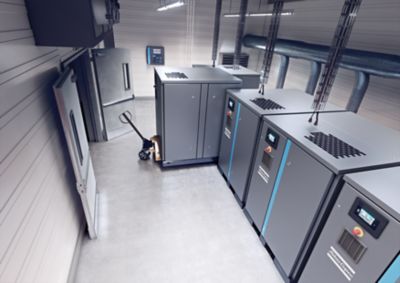Pneumatic grain conveying systems
An incredible volume of grain has to be moved across the globe at any time, for example to and from silos, within processing facilities, and on trucks, trains, and ships.
In recent years, pneumatic conveying has emerged as the preferred (and best) method of transporting grain. Its efficiency and reliability offer grain processors not just financial but also operational benefits.
However, it takes the right equipment to tap into the full potential of pneumatic grain conveying systems.
How is grain conveyed?
Pneumatic conveying is the ideal technology for transporting bulk materials like grain. However, not all types of grain are the same. The size, weight and type of grain can affect the required flow and pressure, and therefore the size of the blower or compressor required. Fortunately, there are different types of pneumatic grain conveying systems to choose from in order to perfectly accommodate the type of grain that has to be moved. In particular, a distinction is made between dilute phase and dense phase conveying . For grains, both the dilute and dense phases can be used, which is another reason why pneumatic conveying is the optimal technology for moving it.
Aside from knowing in which phase your material is being conveyed, you need to consider the size of your new or existing installation. You are going to want to ensure that you have the right flow and air pressure for the type of grain you have to convey. You need to properly size your system to create a smooth and efficient conveying process. An incorrectly sized blower or compressor could lead to high energy bills, frequent blockages, and long unloading times.
Safety & quality aspects to consider when conveying grain
Unlike other bulk materials, when you convey grain, you have to meet certain food safety standards. In addition, because grain dust is highly combustible, you also have to take into account the physical safety of the production/processing facility.
For both reasons, grains should be transported at a temperature not exceeding 40°C. Anything above could trigger an explosion or diminish the quality of the grain.
Furthermore, because the air comes into direct contact with the conveyed materials, it is important to use oil-free blowers and compressors for this process to ensure that there is no oil contamination of your product.
Designing the optimal pneumatic grain conveying system
A well-designed system addresses all of these issues and will allow you to efficiently and safely move large volumes of grain without impacting its quality.
Oil-free air blowers and compressors for grain conveying
To ensure the optimal efficiency of your system, you need a correctly sized blower or air compressor. Defining their proper size can be difficult and may require specialized software. Even if you’re dealing with an existing installation, a one-on-one replacement of the old equipment is often not the most efficient solution. That is why you should make sure to do a sizing check before you invest in a new blower or compressor.
Class 0 to avoid oil contamination
On top of that, the ideal compressor or blower for your grain conveying system has to deliver Class 0-certified or oil-free air. The Class 0 certification ensures there is no oil added to the air during the compression process.
Certified for high risk environments
In addition, some types of grain require equipment that is certified for operation in high-risk environments to prevent explosions. You should check local and national regulations to ensure that your equipment meets all relevant requirements.
Aftercoolers
Depeneding on the type of grain, you need to keep the air temperature below a certain point. For most types of grains, the temperature can not exceed 40°C. So in addition to a compressor or blower, you will need an aftercooler. This ensures that the grain is not burned, maintains its quality and does not combust.
Some compressors, feature an integrated aftercooler. In the case of a blower, however, it will have to be installed separately. If you decide to use a water-cooled aftercooler, it may also be necessary to add a chiller. It lowers the water temperature to a manageable and constant level to ensure that the aftercooler can do its job.
Water separator or dryer
However, because aftercoolers create moisture, a water separator or a dryer will also have to be added in order to maintain the quality of the grain. Most integrated aftercoolers feature an integrated water separator.
In certain cases, a dryer can be used instead of a water separator to remove the moisture from the air.
The role of fluidization
Compressed air can also be used for the so-called “fluidization” process when conveying grain from a silo. Here, very low-pressure air is injected at the bottom side walls of the silo. This ensures that the grain does not stick to the sides of the silo and makes it easier to convey, which reduces energy costs.
In case of food-related materials such as grain, the international quality standards do require you to cool and remove the moisture from the compressed air. This means that, unlike the fluidization processes for non-food related materials, you do need ancillaries such as an aftercooler and water separator or dryer when fluidizing grain inside a silo.
Need help optimizing your grain conveying system?
Not sure how to replace your old compressed air system with a new one? Let us help you. The right size of installation is crucial: not only does it help you save on energy costs, it also shortens unloading times and helps you avoid blockages. Calculating the right size of installation is difficult and requires specific software and skills. We can help you find the optimal dilute phase pneumatic powder conveying system by offering you a free sizing calculation.
Checklist for grain conveying systems:
- Correctly sized air blower or compressor
- Class 0 certified
- Certified for operation with combustible materials
- Aftercooler to cool air
- Water separator or dryer to remove moisture

